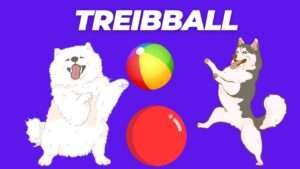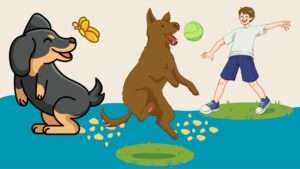In the realm of adorable and awe-inspiring feats, there’s one that never fails to capture hearts and spark smiles: skateboarding dogs.
Picture it: a four-legged friend cruising down the sidewalk, wind in their fur, with an unmatched sense of joy and freedom. It’s a spectacle that transcends mere entertainment, blending companionship with athleticism in a way that’s both endearing and exhilarating.
But how do these furry athletes take to their boards with such finesse? What breeds are best suited for the sport?
And, perhaps most importantly, how can you train your own canine companion to shred like a pro? Join us as we delve into the world of skateboarding dogs, exploring everything from their origins to practical tips for training your pup to roll with the best of them.
Contents Overview
The Origin Story
Skateboarding dogs may seem like a modern phenomenon, fueled by the age of viral videos and social media shares. However, the roots of this unique pastime trace back further than you might expect.
The origin story of skateboarding dogs traces back to the early 2000s when dogs like Tyson and Tillman gained fame for their exceptional skateboarding abilities. Tyson, a bulldog born in October 2001, became famous for skateboarding and appeared on TV shows like The Oprah Winfrey Show and Rob & Big. His owner, Jim Blauvelt, mentioned that Tyson was self-taught and started skateboarding in Huntington Beach, California. Tyson’s performances were considered outstandingly gifted, earning him over $1000 a day.
Story of Famous skateboarding dog Tillman
Tillman was a famous skateboarding dog who gained worldwide recognition for his skateboarding skills. He was an English bulldog that set the Guinness World Record as the fastest skateboarding canine in 2009, with a time of 19.678 seconds over 100 meters at the X Games in Los Angeles.
Tillman’s skateboarding prowess was demonstrated in numerous videos, including a YouTube video that has been viewed more than 21 million times. He also appeared in a commercial for Apple’s iPhone and the Hallmark channel’s reality television series Who Let the Dogs Out.
Tillman’s skateboarding skills were not limited to just skateboarding. He also enjoyed snowboarding, surfing, and riding in an all-terrain vehicle.
Despite his fame, Tillman never learned traditional canine tricks such as rolling over or begging. Instead, he naturally took to skateboarding, which required hundreds of hours of training to master.
Tillman’s popularity extended beyond just skateboarding. He was known for his light brown coat, white face, and white chest, which made him easily recognizable.
Tillman’s owner, Ron Davis, described him as his best friend, brother, and shadow, who made millions of people smile throughout the world.
Tillman’s skateboarding career came to an end when he died in southern California at the age of 10 due to an irregular heartbeat. His death was mourned by his fans, who remembered him as a beloved canine celebrity and a source of inspiration.
The Ideal Breeds for Skateboarding
From intelligence and agility to a fearless spirit of adventure, these breeds stand out as top contenders for mastering the art of skateboarding.
Border Collie:
Description: With their keen intelligence, boundless energy, and eagerness to learn, Border Collies are often hailed as one of the most trainable dog breeds.
Why They Excel: Border Collies thrive on mental stimulation and physical activity, making them ideal candidates for mastering the intricacies of skateboarding. Their agility and quick reflexes allow them to adapt to the shifting dynamics of balancing on a board, while their strong desire to please their owners ensures they’ll give it their all.
Australian Shepherd:
Description: Renowned for their athleticism, loyalty, and versatility, Australian Shepherds are true all-around performers in the world of dog sports.
Why They Excel: Australian Shepherds possess a winning combination of intelligence, agility, and a fearless spirit that makes them naturals on the skateboard. Their strong herding instincts drive them to tackle new challenges with enthusiasm, while their strong bond with their owners ensures they’ll be eager to please both on and off the board.
Jack Russell Terrier:
Description: Small in stature but big in personality, Jack Russell Terriers are known for their boundless energy, fearlessness, and determination.
Why They Excel: Jack Russells approach life with an adventurous spirit and a never-back-down attitude, making them fearless contenders on the skateboard. Their compact size and nimble agility allow them to navigate obstacles with ease, while their high energy levels ensure they’ll have plenty of stamina for mastering new tricks and maneuvers.
Other Breeds to Consider:
While Border Collies, Australian Shepherds, and Jack Russell Terriers are often touted as top choices for skateboarding dogs, they’re by no means the only breeds capable of excelling in the sport. Other breeds that may shine on the skateboard include:
- Siberian Husky: Known for their endurance, strength, and love of activity, Siberian Huskies can make impressive skateboarding partners, particularly in cooler climates.
- Golden Retriever: With their friendly disposition, intelligence, and willingness to please, Golden Retrievers can take to skateboarding with enthusiasm, especially with patient training and encouragement.
- Pit Bull Terrier: Despite their sometimes-maligned reputation, Pit Bulls are often skilled athletes with a natural aptitude for activities like skateboarding, thanks to their strength, agility, and intelligence.
Training Tips
Training a dog to skateboard requires patience, consistency, and a solid understanding of canine behavior. Whether you’re starting from scratch or fine-tuning your pup’s skills, here are detailed training tips to help your furry friend become a skateboarding sensation:
- Introduce the Board Gradually:
Explanation: Dogs are naturally curious, but they can also be cautious of new objects. To prevent fear or anxiety, introduce the skateboard gradually and in a positive context.
Tips:
- Begin by placing the skateboard in an area where your dog feels comfortable, such as their favorite room or the backyard.
- Allow your dog to approach the skateboard at their own pace. Encourage exploration with treats, praise, and gentle encouragement.
- If your dog shows any signs of fear or hesitation, back off and try again later. Never force your dog to interact with the skateboard.
- Associate the Board with Positive Experiences:
Explanation: Dogs learn best when they associate new experiences with positive outcomes. By pairing the skateboard with rewards and praise, you can create a positive association that motivates your dog to engage with the board.
Tips:
- Use high-value treats or toys to reward your dog for interacting with the skateboard. Start by rewarding simple behaviors, such as sniffing or touching the board with their nose.
- Incorporate play into training sessions to make them more enjoyable for your dog. Use toys or games to reinforce positive associations with the skateboard.
- Be patient and consistent with rewards. Even small efforts, such as looking at the board or approaching it without fear, should be acknowledged and rewarded.
- Teach Basic Commands:
Explanation: Basic obedience commands form the foundation of skateboarding skills. Before hitting the pavement, ensure your dog responds reliably to commands such as “sit,” “stay,” and “come.”
Tips:
- Practice obedience commands in a variety of environments to generalize your dog’s skills. Start in a quiet, familiar space, then gradually add distractions and challenges.
- Use positive reinforcement techniques, such as treats and praise, to reward desired behaviors. Consistency is key to building strong obedience skills.
- Incorporate obedience training into skateboarding sessions to reinforce control and safety. For example, ask your dog to “sit” before getting on the skateboard and “stay” while riding.
- Start Slow:
Explanation: Skateboarding can be intimidating for dogs, especially if they’re not used to balancing on a moving surface. Start with slow, controlled movements to build your dog’s confidence and comfort level.
Tips:
- Begin training on a flat, smooth surface with plenty of space for your dog to move around safely. Avoid crowded or busy areas, as they can be distracting and overwhelming for beginners.
- Hold onto your dog’s leash or harness to provide support and guidance during initial attempts. Start by simply standing on the skateboard while holding onto your dog, allowing them to get used to the sensation of movement.
- Gradually introduce rolling movements by gently pushing off with your foot while holding onto your dog’s leash. Start with short distances and slow speeds, gradually increasing both as your dog becomes more comfortable.
- Gradually Increase Difficulty:
Explanation: As your dog gains confidence and skill on the skateboard, gradually increase the difficulty of training exercises to challenge their abilities and expand their repertoire of tricks.
Tips:
- Introduce slight inclines, turns, and obstacles to simulate real-world skateboarding conditions. Start with small, manageable challenges, then gradually increase the difficulty as your dog improves.
- Break down complex tricks into smaller, achievable steps. For example, if you’re teaching your dog to turn while skateboarding, start by practicing gentle turns in one direction before progressing to sharper turns or changes in direction.
- Be patient and supportive during training sessions. Offer plenty of encouragement and praise for even small improvements, and don’t be discouraged by setbacks or mistakes.
- Be Patient and Positive:
Explanation: Training a dog to skateboard takes time and patience. Approach each training session with a positive attitude and a willingness to adapt your approach based on your dog’s progress and preferences.
Tips:
- Stay calm and patient, even if your dog struggles or becomes frustrated. Dogs pick up on their owner’s emotions, so maintaining a positive attitude can help keep training sessions enjoyable and productive.
- Break training sessions into short, manageable segments to prevent fatigue and maintain your dog’s focus and motivation. Aim for multiple short sessions throughout the day rather than one long session.
- Celebrate your dog’s progress and achievements, no matter how small. Remember that every dog learns at their own pace, and progress may be slower for some dogs than others.
By following these detailed training tips and techniques, you can set your dog up for success on the skateboard while strengthening your bond through positive, rewarding interactions. With patience, consistency, and a lot of love, you and your furry friend can conquer the skate park together.
Safety First
Ensuring the safety of both you and your dog is paramount when it comes to skateboarding together. By taking proactive measures and prioritizing safety at all times, you can enjoy this thrilling activity while minimizing the risk of accidents or injuries. Here’s a comprehensive guide to putting safety first when skateboarding with your dog:
- Proper Equipment:
Explanation: Before hitting the streets, make sure both you and your dog are equipped with the necessary safety gear to protect against falls, collisions, and other potential hazards.
Tips:
- Helmet: Always wear a properly fitted helmet to protect your head in case of falls or collisions. Look for helmets designed for skateboarding or biking, which offer maximum protection and comfort.
- Protective Gear: Consider wearing additional protective gear such as knee pads, elbow pads, and wrist guards to minimize the risk of injury in the event of a fall.
- Harness or Collar: Ensure your dog is wearing a well-fitted harness or collar and leash to maintain control during rides. Avoid using retractable leashes, as they can be difficult to control and pose a tripping hazard.
- Choose Suitable Locations:
Explanation: Selecting appropriate skateboarding locations is essential for ensuring both safety and enjoyment. Look for areas with smooth surfaces, minimal traffic, and no potential hazards that could pose a danger to you or your dog.
Tips:
- Skate Parks: Consider visiting skate parks designed specifically for skateboarding, where you can find smooth surfaces, ramps, and other features designed for safe skating.
- Empty Parking Lots: Empty parking lots can provide ample space for skateboarding practice with minimal traffic and distractions. Look for lots with smooth pavement and few obstacles.
- Quiet Neighborhood Streets: If you prefer to skate on streets or sidewalks, choose quiet residential areas with minimal traffic and pedestrian activity. Avoid busy streets, intersections, and areas with poor visibility.
- Start Slow and Gradually Increase Difficulty:
Explanation: When introducing your dog to skateboarding, start with simple, low-risk maneuvers and gradually increase the difficulty as both you and your dog become more comfortable and proficient.
Tips:
- Slow Speeds: Begin with slow, controlled movements to allow your dog to adjust to the sensation of skateboarding. Avoid high speeds or sudden movements that could startle or overwhelm your dog.
- Flat Surfaces: Start training on flat, smooth surfaces before attempting more challenging terrain such as hills or ramps. This allows your dog to build confidence and balance in a safe environment.
- Gradual Progression: Introduce new skills and challenges gradually, allowing your dog to master one skill before moving on to the next. Break down complex maneuvers into smaller, achievable steps to prevent frustration and build confidence.
- Monitor Your Dog’s Behavior:
Explanation: Pay close attention to your dog’s behavior during skateboarding sessions to ensure they are comfortable, relaxed, and enjoying the experience. Watch for signs of fatigue, discomfort, or stress, and be prepared to stop or modify your activities accordingly.
Tips:
- Body Language: Learn to recognize your dog’s body language and facial expressions to gauge their comfort level and emotional state. Signs of stress or discomfort may include flattened ears, tucked tail, panting, or attempting to flee.
- Regular Breaks: Take frequent breaks during skateboarding sessions to allow your dog to rest and recharge. Offer plenty of water and shade, especially on hot days, to prevent dehydration and overheating.
- Listen to Your Dog: Trust your instincts and listen to your dog’s cues. If your dog seems hesitant, anxious, or uninterested in skateboarding, it’s important to respect their feelings and end the session.
- Be Prepared for Emergencies:
Explanation: Despite your best efforts to prioritize safety, accidents can still occur. Be prepared for emergencies by carrying a basic first aid kit and knowing how to respond to common injuries.
Tips:
- First Aid Kit: Carry a first aid kit containing essentials such as bandages, antiseptic wipes, gauze pads, and tweezers. Familiarize yourself with basic first aid procedures for treating cuts, scrapes, and other minor injuries.
- Emergency Contacts: Keep a list of emergency contacts, including your veterinarian’s contact information and the phone number for local animal control or emergency veterinary services.
- Know When to Seek Help: In the event of a serious injury or medical emergency, seek immediate veterinary care. Don’t hesitate to call for assistance if you’re unable to transport your dog to the vet yourself.
- Train for Control and Safety:
Explanation: Prioritize training and obedience to ensure your dog can respond reliably to commands and maintain control during skateboarding sessions. This not only enhances safety but also strengthens the bond between you and your dog.
Tips:
- Basic Commands: Teach your dog basic obedience commands such as “sit,” “stay,” “come,” and “heel” to maintain control and prevent accidents while skateboarding.
- Practice Off-Leash Control: Train your dog to respond to commands off-leash in a controlled environment before attempting off-leash skateboarding. Use positive reinforcement techniques to reinforce desired behaviors.
- Safety Commands: Introduce safety commands such as “stop” or “wait” to help your dog understand when to pause or disengage from skateboarding activities. Practice these commands regularly to ensure they’re reliable in real-world situations.
Bottom Line
In the world of skateboarding, few sights are as heartwarming and impressive as a dog confidently cruising on four wheels. From their humble beginnings to their rise to viral stardom, skateboarding dogs have captured the imagination of people around the world, proving that with dedication and love, anything is possible.
Whether you’re considering training your own pup to skate or simply marveling at the talents of these canine athletes, one thing is certain: the bond between human and dog knows no bounds, transcending language, culture, and even gravity. So, grab your board, leash up your best friend, and get ready to embark on a journey of adventure and companionship—paws on wheels, and the open road ahead.



























+ There are no comments
Add yours